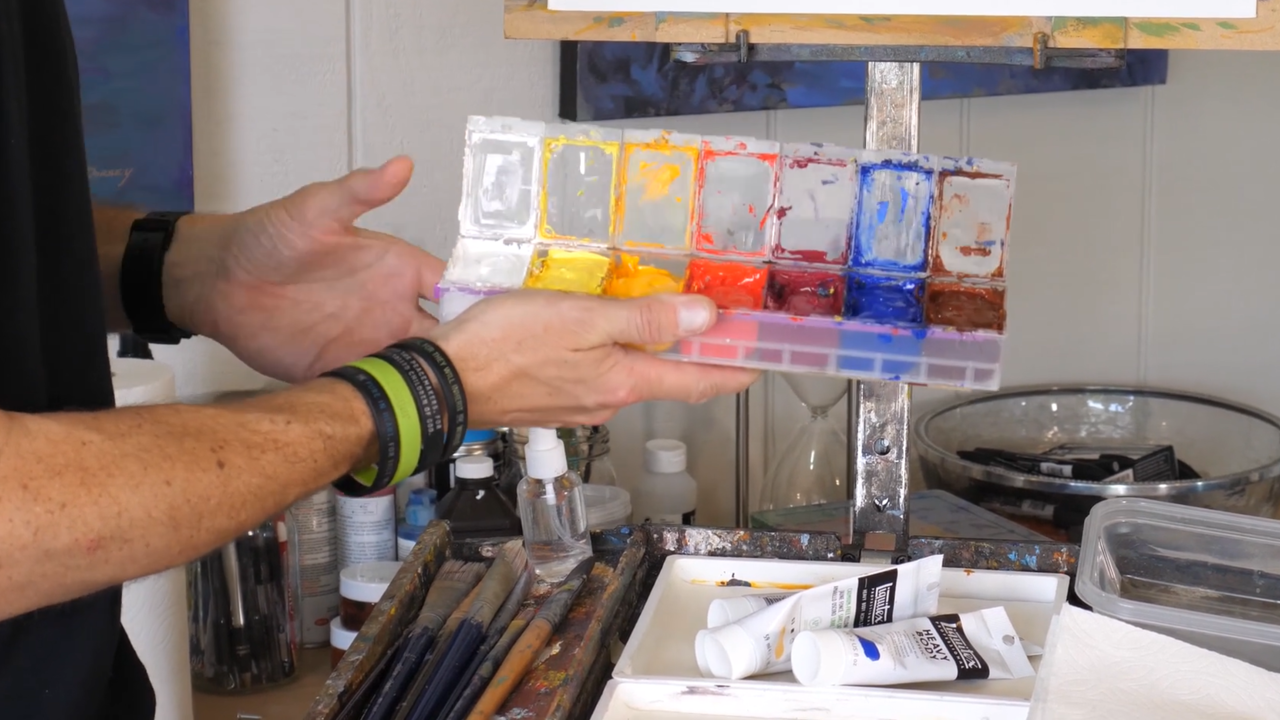Size to Paint, How to Store, & Selling in Restaurants

Hey, friends, I hope everybody had a good Thanksgiving if you're from the US, of course.
We have three questions in a row from Nancy.
"What Size Should I Paint and Try to Sell?"

She asks: "Is it best to paint the same sizes as a rule? I keep trying to appeal to all kinds of buyers with very small works and up to 11 by 14. It is so hard to sell art in this area that I keep thinking if I have lower items, people will buy more. Yet, it does not seem worth the time for that small stuff sometimes."
Certain places are not as good geographically for selling artwork as other areas due to limitations in the amount of money that's in an area. Not everybody in the world thinks that art is as important as other people do. And not everybody in the world has the money to pay for art even if they do believe that it is beautiful and significant.

Finding ways to get your art in front of people, who, one, think that it's significant, and two, have the money to be able to buy is really important. And then, there's this third part where you have to find somebody who connects with your painting on an emotional level and who thinks, "I need that. That painting right there, I need that in my house. I need that in my life." It's always an emotional connection that gets us to make a purchase.
Sometimes painting smaller is excellent because it does provide a lower entry point. I'm a firm believer in having your size correlate to your price. So if you have a smaller painting, it should be less expensive than a bigger painting. So if all you have are big paintings, then you might not be able to sell work at that lower level where a more significant portion of the population wouldn't be able to buy it. It is good to have a range in the sizes that you paint.
If you put the same amount of time into a small painting that sells for $100 as a bigger painting that sells for $300 (because sometimes small paintings take almost as long as a bigger painting), you have to ask yourself if it's worth it? Maybe you're trying to appeal to this lower market, but you have to sell three paintings at $100 to make up for one painting that you could sell for $300. And if it took three times the amount of time to paint three paintings, than it did to do the one painting for $300. You have to weigh how frequently you can sell small paintings versus how often you can sell the bigger painting. Remember, though, that by selling smaller paintings, you can allow people to become collectors of your work at a lower price point, and later on, they may be able to afford a more expensive piece.

But there's an underlying more significant philosophy in creating art for sale. You must create the best quality of art you can and keep working on creating beautiful art.
09:15 I took a workshop from Robert Genn a long time ago, and he would always tell people who want to be professional artists, "Go away, paint one hundred paintings and come back when you're done and show them all to me then we'll talk. Don't tell me you want to be a professional artist until you paint 100 paintings at least, and then we'll talk." He also said, "I've never seen a fantastic artist who didn't make it. You will be found out. You can't hide. When you become a great artist, you won't be able to hide in your work. People won't ignore it." If you reach that level, the problem won't be so much not being found. You will be found. But the problem is, we sometimes settle for a standard that's not quite high enough. And so, sometimes we have to press ourselves and say, "Okay, I just need to keep working and keep growing." And I'm still in that place. You will never outgrow that place.
10:58 That's the striving for excellence journey that we're all on––we're all wanting to get better. And what's great about that is, it's fun because if we somehow reached what we thought was our goal, then the challenge of painting would go away and it would get boring.
For me, painting is challenging every time I pick up my paintbrush, and I put it to canvas. I never run out of challenges and problems that I keep having to solve. That's what I think makes painting fun, and I think it's what makes it good for us physically and mentally because it keeps your brain engaging and working, and it's healthy for us to do that. So keep working and creating goals.
Tell yourself, I'm going to keep painting a lot, and I'm going to work on small and mid-size and some large paintings, and I'm going to test the market a bit and see what happens. We need to start somewhere in terms of trying to sell our work if that's what your goal is. And as a word of advice, It feels so much better to sell a painting for less money than to have a bunch of paintings that are high-priced in your closet because you can't sell them.
12:58 I'm a firm believer, especially when you're starting, you should keep your prices a little bit more reasonable and allow people to have that entry point. But you also have to know your area. Different areas have different buying capacities, and they're not all equal, so figuring out ways of getting your paintings into other arenas can be helpful.
"How do you store your paintings?"

I stack them vertically if they're small enough. I have a couple shelves that have small ones. I don't have a ton of painting sitting around unless their either incomplete paintings or bad paintings that I haven't finished or don't want to show until I have the chance to solve the problems in them. Store paintings just like books, keep them vertical and keep them dry. Keep paintings where you won't have moisture issues.
"How do you paint loose and not get caught up in the details?"

15:31 Grab the biggest brush that you have and don't grab a smaller brush. That's the easiest and most straightforward answer. Just keep the big brush in your hand and honestly, force yourself not to use smaller brushes. Maybe at the very end take out a small brush and give yourself a limited number of brush strokes with it. That is one of my practices. I also step back and squint and look at the big picture, because the big picture matters more than the little details. A lot of times, we're working on small details, and they don't help. Remember that they don't make as big of a difference as the bigger shapes and the more prominent structures in the painting. And so, you don't always need as many small, small details as you might think. So, go with the big brush.
"How do you make an acrylic painting look like it was done with oil?"

Jed Dorsey - "Soft Day at Camano Crossing"
Soft edges and blended colors.
18:35 Because oils take so long to dry, you can come back hours or days later and blend in the edges and colors—that's what's distinct about them. A lot of times, with acrylic paintings, people don't spend time working to soften those edges. And so it looks a little bit plasticky, hard, and cut out. Taking time to create soft edges is essential.
19:14 A big transformational time in my career was when I started using the Stay Wet palette because I was able to blend colors; I was able to mix longer and keep the paint wet longer. I was no longer just grabbing a tube color. I use colors that I've mixed on my palette, and then, as they get blended and nuanced, it works on the painting to harmonize colors and do things that are also subtler. When you're blending, keep intermixing those colors to create nuanced mixes. And not just straight-from-the-tube kind of colors.
20:36 "I've read that there is a brand of acrylic paint which keeps its color value and doesn't darken more when it dries. Do you know anything about this?"

What Sarah is referring to is how acrylic paint will dry about a half-shade darker than when it's wet. Different paints are better at retaining their color and won't dry as dark as other brands. I've never heard of paint that totally doesn't change, but there are better ones.
About three years ago, I read an article that said Utrecht was the best brand overall for a few different things. They'd surveyed probably 100 artists who were using all these different brands, and they gave them several of the major brands to try. They came away saying that Utrecht was overall the favorite brand, from consistency to the color shift, which is what we're talking about now, the shifting of color as it dries, to the workability of it, and different things like this. So Utrecht has been recommended for that.
I also don't think Golden or Liquitex are bad at it. Where I see issues are with student-grade paints because I believe that student-grade paints can cause a bit of a problem because they will have more filler and less pigment. The filler will be watery filler, and then when it dries, it evaporates and it tends to change the color more. If you buy artist-grade paint, it's going to be better.
23:21 What plein air paintbox do you and Diana Shyne use? I want to use a limited palette.

My plein air paintbox has seven compartments. The thing that's so awesome about these is that they're just bead boxes from Michaels. And you can get this for about $3 or $4.
The one that you saw Diana Shyne using was a little bit smaller, but both of these can be found at a craft store like Michaels or Hobby Lobby. They're very easy to find and super useful. I've also created an attachment so that it will sit on my easel easily. Fishing lure boxes are also great, too, and some even have watertight seals.
26:32 Dorina asks a business side of art question: "I'm thinking of hanging a couple of paintings in a local restaurant, but I'm wondering how to approach it. Do you have a contract and have them handle the sale and give them a commission, or do you just put your contact info on a card there and have the people or the restaurant refer people back to you?" Have you done this, or is it best to stick with just galleries?"

Kim asks a follow-up question "I have a friend who has a boutique and sells antiques and artwork, and she has asked for my paintings. How do I approach this?"
I'm not a lawyer, so don't take any of my advice in some legal way. I don't have enough knowledge to speak in that manner, but it depends on the situation. I don't know if you need a contract. The restaurant owner may have a standard policy, but if they don't have any experience hanging artwork in their place, then I would just come to a mutual agreement. I might say, "Let's try this for the first month or two." Do something where you're not locking yourself into a long-term arrangement with them just in case you want to change it.

If the restaurant or the boutique already has art, then they probably have a policy in place or something that they've done with other artists in the past. And then, I would ask to see what they've already done, and then look at it and see if it's going to work for you?
The beautiful thing about a boutique or a restaurant is that it's easier to show work. Sometimes galleries can be really hard to get into. But a storefront or a restaurant often looks for stuff that they can hang on their walls. They want their restaurant to look beautiful, and if your paintings would add to their aesthetic, then they're going to love to have your painting; it can be a good win-win.

My dad was a professional artist when I was very young, and then he ended up working for Boeing for a number of years. When he was working for Boeing, he still was selling paintings at a restaurant. I have memories of driving around the restaurant sometimes at night looking into the restaurant to see if any of my dad's paintings had sold. He sold lots of paintings there.
So, it can be a matter of what kind of restaurant it is or what kind of boutique and what kind of clientele come in there. Also, if the owners speak well of your work, that can be pretty incredible and increase your sales. And in those situations, you want to give them an incentive like a commission and make them feel like they're part of the team.
31:29 For example, I was at a plein air event a few years ago, and I had to leave my booth, I had a few paintings from the week that I'd done and I had to leave for a little while, and a man there said he'd take care of my booth. I was gone for about 20 minutes, and when I came back, he'd sold one of my paintings, and I said, "Oh my goodness. Who are you?" He was a curator at an art museum on the other side of the state. This was in Indiana, but the guy was an incredible salesperson, and if he believed in your work, he could sell your work like crazy.
From then on, anytime I had a chance to put my work in his museum or do something in a show of his, I did it because that guy sold the work as much as my paintings did. You can have a painting in a nice gallery, but if the gallery owner doesn't help promote you, it might not matter that you're in that really nice gallery. So it's better to be in a smaller gallery or a smaller venue with people that are really for you than being one of twenty-five artists in a really fancy gallery where you're just one of the many, and you don't really get that much attention or love from the owner.
Communication is the key. It's good to get things in writing so that you have something to fall back on. And I would tend to say, if you really don't know what to do and the other person doesn't know what to do, then do a trial, so that you're not locked into something that has to be forever. That way, either side can say, "You know what? I think it would work better if we adjusted things this way."
37:14 As far as commissions go, I would be pretty hesitant to pay more than 30% on any commission in a restaurant or storefront. Many coffeehouses, bakeries, restaurants, etc. won't ask for any commission, and that can be an ideal situation for you. Galleries often take 50% commission. You get 50% and they get 50% of a sale. If you find a gallery that takes 30% or 40%, that's a pretty good deal, and I would jump on it.

Restaurants and storefronts are usually on the lower end. I would not agree to a commission of 50% in a restaurant unless it's a super high-end restaurant that's going to bring you a lot of work or get high-end clients in front of your pieces because you're adding as much to their aesthetic. Quite often, that's why they don't even really want a commission. They're just looking to have your work on the wall because it's a service to them to have beautiful paintings in their establishment.
Even if you don't sell anything, part of the reason that you would show in restaurants is exposure. You're getting your name out there. Have your business cards there with your contact info and website. It might not immediately result in a sale, but maybe six months down the road, you might have somebody who follows up with you, and it never hurts to have more exposure as an artist.




